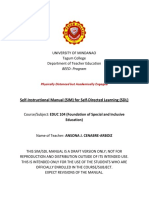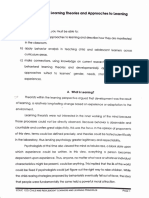0 ratings0% found this document useful (0 votes)
431 views1.3 Lev Vygotsky's Scaffolding 1.4 Jean Lave's Situated Learning
1.3 Lev Vygotsky's Scaffolding 1.4 Jean Lave's Situated Learning
Uploaded by
Frenz Lastimoso EgeVygotsky's sociocultural theory of development emphasizes that cognitive development occurs through social interaction and culture. According to Vygotsky, learning is facilitated by scaffolding and the zone of proximal development. Scaffolding involves providing support that allows children to accomplish tasks they cannot do independently. The zone of proximal development defines what a child can do with help versus what they can do alone. Situated learning theory proposed by Lave focuses on authentic learning within real-world contexts rather than memorization. Both theories highlight the importance of social and cultural influences on learning.
Copyright:
© All Rights Reserved
Available Formats
Download as PDF, TXT or read online from Scribd
1.3 Lev Vygotsky's Scaffolding 1.4 Jean Lave's Situated Learning
1.3 Lev Vygotsky's Scaffolding 1.4 Jean Lave's Situated Learning
Uploaded by
Frenz Lastimoso Ege0 ratings0% found this document useful (0 votes)
431 views24 pagesVygotsky's sociocultural theory of development emphasizes that cognitive development occurs through social interaction and culture. According to Vygotsky, learning is facilitated by scaffolding and the zone of proximal development. Scaffolding involves providing support that allows children to accomplish tasks they cannot do independently. The zone of proximal development defines what a child can do with help versus what they can do alone. Situated learning theory proposed by Lave focuses on authentic learning within real-world contexts rather than memorization. Both theories highlight the importance of social and cultural influences on learning.
Original Title
1.3 Lev Vygotsky's Scaffolding 1.4 Jean Lave's Situated Learning (1)
Copyright
© © All Rights Reserved
Available Formats
PDF, TXT or read online from Scribd
Share this document
Did you find this document useful?
Is this content inappropriate?
Vygotsky's sociocultural theory of development emphasizes that cognitive development occurs through social interaction and culture. According to Vygotsky, learning is facilitated by scaffolding and the zone of proximal development. Scaffolding involves providing support that allows children to accomplish tasks they cannot do independently. The zone of proximal development defines what a child can do with help versus what they can do alone. Situated learning theory proposed by Lave focuses on authentic learning within real-world contexts rather than memorization. Both theories highlight the importance of social and cultural influences on learning.
Copyright:
© All Rights Reserved
Available Formats
Download as PDF, TXT or read online from Scribd
Download as pdf or txt
0 ratings0% found this document useful (0 votes)
431 views24 pages1.3 Lev Vygotsky's Scaffolding 1.4 Jean Lave's Situated Learning
1.3 Lev Vygotsky's Scaffolding 1.4 Jean Lave's Situated Learning
Uploaded by
Frenz Lastimoso EgeVygotsky's sociocultural theory of development emphasizes that cognitive development occurs through social interaction and culture. According to Vygotsky, learning is facilitated by scaffolding and the zone of proximal development. Scaffolding involves providing support that allows children to accomplish tasks they cannot do independently. The zone of proximal development defines what a child can do with help versus what they can do alone. Situated learning theory proposed by Lave focuses on authentic learning within real-world contexts rather than memorization. Both theories highlight the importance of social and cultural influences on learning.
Copyright:
© All Rights Reserved
Available Formats
Download as PDF, TXT or read online from Scribd
Download as pdf or txt
You are on page 1of 24
Lev Vygotsky's Scaffolding
Jean Lave's Situated Learning
Ebrole, Novie Mae E.
BSED Social Studies 2
Sociocultural Theory of Development
• This theory stated that students learn
through social interaction and their culture.
• 3 Central Factors of Cognitive
Development
1. Culture
Vygotsky believed in the
crucial role ofculture played on
the cognitive developmentof children.
2. Social Interaction
• Vygotsky gave more weight on the
social interaction that contributed to
thecognitive development of individuals.
• Vygotsky emphasize that effective
learning happens through participation
in social activities.
3. Language
• Language open the door for learners to
acquire knowledge that other already have.
• Learning use language to understand
and solve problems.
• It helps learners regulate and reflect on
his own thinking.
Private Speech
* Is a form of “self-talk” that guides
the child’s thinking and action.
Hands-on activities
Help children acquire more knowled
than passive listening
Zone of Actual Development
When a child attempts to perform a skill
alone, she may not be proficient at it.
Zone of proximal development
• Zone of proximal development define those
functions that have not yet matured, but are
in the process. The gap between what
a child cando alone and what a child
can with help from adults or peers
who are more capable than the child.
Scaffolding
* The support or assistance that lets the
child accomplished a task he cannot
accomplish independently.
* Involves judicious assistance given by the
adult or peer.
* Adult unzips the zipper an inch or
two and then.
Example of scaffolding:
• Adult unzips the zipper an inch or
two and then holds the lunch bag
so that the child can continue to
unzip the lunch bag.
• Loosing the food container lid just a
bit and letting child open the lid himself.
Scaffolding and Fade-away Technique
• Withdrawing the guidance when the child
could do on their own what they
could not initially do without assistance.
Vygotsky Theory
• Cognitive development is a product of
social interaction.
• Claims that there is a strong connection
between learning language and the
development of thinking.
• Highlights the role of mentor in cognitive
development.
• Well applied to teaching strategies.
• More social in focus.
• Emphasized on cultural factors in cognitive development.
Jean Lave Situated Learning
• PhD in social anthropology
• Social anthropologist
• Social learning theorist
• Graduated with a doctorate from
Harvard University in 1998
3 main characteristics
• Learning the unintentional and located within an
authentic setting.
• To improve learning by motivating students and by
providing a rich context for them.
• Emphasizes the context and applicationof knowledge
rather than memorizing facts.
Strength
• Brings real world experience into the classroom
• Allow student to make conclusions for themselves.
• Gets away from just memorizing facts.
Weakness
• Teachers role changes from expert tosimply facilitating
and with this runs the risks of students
making incorrect conclusions.
• Situated learning may be deemed irresponsible
as it has the potential to cast
professional teaching strategies to the side
which often make content accessible to students.
Relate to Constructivism
• Constructivism- type of learning that explains human
learning as an active attempt to construct
meaning in the world around us.
• Situated learning brings real world experience to
the classroom so they can take what they
learned back out into the world.
Situated Learning Classroom
• Starts early in elementary school-teachers independence
and self-exploration.
• Teachers: inquiry-based theory; helps steer
them toward. interests.
• Group seating; promote cooperation and collaboration.
• Computer center, smart board, Elmo, clickers
for smart board.
• Goals, Promote individual growth through
real world experience.
References Sources
• http://www.personal.psu.edu/wxh139/Situated.htm
• http://wwwlearning-theories.com/situated-learning-theory-
lave.html
• http:theydiffer.com/difference-between-piaget-and-vygotsky-
theories
•Thank you!
You might also like
- Group A Vocabulary Grammar: PromiseDocument2 pagesGroup A Vocabulary Grammar: PromiseMarija100% (2)
- FTC 3.4 Module 4 WK 7 8 - The Teachers - Organizational LeadershipDocument9 pagesFTC 3.4 Module 4 WK 7 8 - The Teachers - Organizational LeadershipMarianlou Chatto Lampon Yarot100% (1)
- EdtechDocument6 pagesEdtechJC UNGRIA50% (2)
- Elementary Grammar Games PDFDocument128 pagesElementary Grammar Games PDFhead_the_ball6384100% (5)
- Fis Module 5Document13 pagesFis Module 5roxan clabriaNo ratings yet
- PROF ED 102 Course NotesDocument15 pagesPROF ED 102 Course NotesKaren Roldan RosalejosNo ratings yet
- Educ104 SIM - SDL EDITED PDFDocument130 pagesEduc104 SIM - SDL EDITED PDFNorienne TeodoroNo ratings yet
- A Concept Map of A Multi - PED2Document1 pageA Concept Map of A Multi - PED2Erirose ApolinarioNo ratings yet
- Ped 11Document4 pagesPed 11Jomer JosolNo ratings yet
- Introduction and Module 1 (TTL)Document8 pagesIntroduction and Module 1 (TTL)Kristine Castle100% (1)
- Questions For ReflectionDocument1 pageQuestions For ReflectionFernand ClaudNo ratings yet
- Essentialism, Perennialism, Progressivism, and Social Reconstructionism)Document1 pageEssentialism, Perennialism, Progressivism, and Social Reconstructionism)Romeo Jr Vicente Ramirez100% (1)
- Digital Safety Rules. Cyber Safety.Document27 pagesDigital Safety Rules. Cyber Safety.Arah Lazara100% (2)
- IdealismDocument10 pagesIdealismirene ilustrisimoNo ratings yet
- Final Coverage Foundations of Special and Inclusive EducationDocument28 pagesFinal Coverage Foundations of Special and Inclusive EducationSheena LiagaoNo ratings yet
- Home Economics Literacy Module 1 2 CompressDocument8 pagesHome Economics Literacy Module 1 2 Compressnlbb2023-3278-47337100% (1)
- Characteristics of Good Learning OutcomesDocument1 pageCharacteristics of Good Learning OutcomesEstolas Shiena P.No ratings yet
- Fsie Compilation of Reports MidtermDocument8 pagesFsie Compilation of Reports MidtermjmmelanioNo ratings yet
- ProfEd 3Document9 pagesProfEd 3Cid HannahNo ratings yet
- The Child and Adolescent Learners and Learning Principles Module PDFDocument17 pagesThe Child and Adolescent Learners and Learning Principles Module PDFAnnie JoeNo ratings yet
- Educational Assessment of Students With Additional NeedsDocument2 pagesEducational Assessment of Students With Additional NeedsRazelle Angiela Avorque100% (1)
- Ped 103Document14 pagesPed 103Johanna Mitzi MacatangayNo ratings yet
- Social Dimensions of Education Exam 1Document16 pagesSocial Dimensions of Education Exam 1Vince OcionesNo ratings yet
- Activity 1Document3 pagesActivity 1Joshua BaguioNo ratings yet
- Appropriateness of Assessment Methods Assessment Instruments AppropriatenessDocument3 pagesAppropriateness of Assessment Methods Assessment Instruments AppropriatenessJaysonNo ratings yet
- Session 6 Magna CartaDocument20 pagesSession 6 Magna CartaJacqueline DionisioNo ratings yet
- Unit I-Chapter 2 The TeacherDocument4 pagesUnit I-Chapter 2 The TeacherJane Tricia Dela Peña - NuquiNo ratings yet
- 20 Century Education 21 Century Education: TH STDocument1 page20 Century Education 21 Century Education: TH STNarciso LicayanNo ratings yet
- School As An OrganizationDocument15 pagesSchool As An OrganizationMaria Emmalyn MatozaNo ratings yet
- Reflection Unit 3 Module 6 - Cynthia P. LimDocument2 pagesReflection Unit 3 Module 6 - Cynthia P. LimCynthia LimNo ratings yet
- MODULE 2 Lessons 1 and 2Document3 pagesMODULE 2 Lessons 1 and 2ANNAH GOMEZNo ratings yet
- Learning Episode 5:assessing Technology Integration in The ClassroomDocument6 pagesLearning Episode 5:assessing Technology Integration in The ClassroomjacintodanycamarieNo ratings yet
- The Effect of The TeacherDocument6 pagesThe Effect of The TeacherRodel Ramos DaquioagNo ratings yet
- Self-Check, Reflection On Stakeholders in Curr. ImplementationDocument3 pagesSelf-Check, Reflection On Stakeholders in Curr. Implementationannabelle castaneda100% (1)
- Assure Lesson PlanDocument4 pagesAssure Lesson Planapi-242546982100% (1)
- TTL 1 Presentation 1 AnswerDocument3 pagesTTL 1 Presentation 1 Answerjooo meeeooowNo ratings yet
- Risks ICT E-Networking: Some in The Use of andDocument17 pagesRisks ICT E-Networking: Some in The Use of andErika Mae TupagNo ratings yet
- Field Study Guide in Edfs 21 Course Title: Field Study 1 - Observations of Teaching - Learning inDocument8 pagesField Study Guide in Edfs 21 Course Title: Field Study 1 - Observations of Teaching - Learning inchaeyoung momieNo ratings yet
- Group 10 Learners With Difficult CircumstancesDocument58 pagesGroup 10 Learners With Difficult CircumstancesRio Manuel ValenteNo ratings yet
- Course Content in Edu 40 Assessment of Student Learning 1 Course DescriptionDocument3 pagesCourse Content in Edu 40 Assessment of Student Learning 1 Course DescriptionAntonette FrondaNo ratings yet
- Module 1 Assessment in Learning 1 1Document7 pagesModule 1 Assessment in Learning 1 1Ray BelardoNo ratings yet
- Ed 8 Midterm Exam (2023)Document6 pagesEd 8 Midterm Exam (2023)Frank Mecel Arzaga DimalantaNo ratings yet
- FINAL 24 Bridging The Gap Between K 12 Graduates and Employment Final 0921042 20210903Document8 pagesFINAL 24 Bridging The Gap Between K 12 Graduates and Employment Final 0921042 20210903Carylle Joy SalindayaoNo ratings yet
- Lesson 5 Construction of Written TestsDocument16 pagesLesson 5 Construction of Written TestsRylNo ratings yet
- Research in Child and Adolescent Development: Study Guide For Module No. 5Document5 pagesResearch in Child and Adolescent Development: Study Guide For Module No. 5Darlene Dacanay DavidNo ratings yet
- GE7 - Modules 11 and 12Document12 pagesGE7 - Modules 11 and 12Rojean TinggasNo ratings yet
- Final PapaerDocument23 pagesFinal PapaerAlexandriteNo ratings yet
- Technology Collaborative Tools in The Digital WorldDocument6 pagesTechnology Collaborative Tools in The Digital WorldRonibe B MalinginNo ratings yet
- Btled Program StudyDocument3 pagesBtled Program StudyGeraldine TingbawenNo ratings yet
- Education in The New MilieuDocument19 pagesEducation in The New MilieuLara OñaralNo ratings yet
- The Teaching Professio (Midterm Exam)Document4 pagesThe Teaching Professio (Midterm Exam)Rhyan Perdon SmithNo ratings yet
- Module 6 - Research in ChildDocument6 pagesModule 6 - Research in Childrushy121No ratings yet
- Ped 101 SyllabusDocument8 pagesPed 101 SyllabusAPRIL AURA CACHONo ratings yet
- Socio-Emotional Development of The PreschoolerDocument5 pagesSocio-Emotional Development of The PreschoolerBasco Martin JrNo ratings yet
- Lesson 1: Learner-Centered Psychological Principles (LCP)Document5 pagesLesson 1: Learner-Centered Psychological Principles (LCP)cee padillaNo ratings yet
- Globalization and Teacher Exchange ProgramsDocument24 pagesGlobalization and Teacher Exchange ProgramsCindy De Pablo GarciaNo ratings yet
- Multicultural Diversity: A Challenge To Global Teachers"Document1 pageMulticultural Diversity: A Challenge To Global Teachers"jasminNo ratings yet
- The Role of Technology in Delivering The CurriculumDocument16 pagesThe Role of Technology in Delivering The CurriculumImie Omamalin Guisehan94% (16)
- El 115 Prelim Module 1Document33 pagesEl 115 Prelim Module 1Ella Marie Gamayon PoloNo ratings yet
- Building and Enhancing New With Emphasis On 21: Literacies in The CurriculumDocument24 pagesBuilding and Enhancing New With Emphasis On 21: Literacies in The Curriculumsherlyn tabosoNo ratings yet
- Transitions to K–12 Education Systems: Experiences from Five Case CountriesFrom EverandTransitions to K–12 Education Systems: Experiences from Five Case CountriesRating: 4 out of 5 stars4/5 (2)
- Reviewer (Prof Ed)Document8 pagesReviewer (Prof Ed)Jan Roldan GiducosNo ratings yet
- Purposive Communication: Background and RationaleDocument29 pagesPurposive Communication: Background and RationalePrincess Siblag ConcepcionNo ratings yet
- BBUS3671 NAG MajorProjectDocument25 pagesBBUS3671 NAG MajorProjectamlannag6No ratings yet
- 2022 McKinsey Taipei Scholar ProgramDocument5 pages2022 McKinsey Taipei Scholar Program巫信霈No ratings yet
- DLP Prose EditedDocument35 pagesDLP Prose EditedAlyz Loraine AbuyenNo ratings yet
- Curriculum Map 2019-2020: Immaculate Conception School of Guiuan, IncDocument3 pagesCurriculum Map 2019-2020: Immaculate Conception School of Guiuan, IncJessa Mae Badar MacasojotNo ratings yet
- Lesson Plan 4Document4 pagesLesson Plan 4api-339167965No ratings yet
- Chapter SEVEN - ACTIVITIES.Speaking PDFDocument19 pagesChapter SEVEN - ACTIVITIES.Speaking PDFEsther Ponmalar Charles100% (1)
- Teaching For Conceptual Change PDFDocument25 pagesTeaching For Conceptual Change PDFMat Tjs100% (1)
- Exercise Benefits Brain ArticleDocument4 pagesExercise Benefits Brain Articleapi-310709379No ratings yet
- Thesis SampleDocument117 pagesThesis SampleMa. Fe Roxane SiuaganNo ratings yet
- Life Skills Lesson Plans Grade 3 Week 5Document4 pagesLife Skills Lesson Plans Grade 3 Week 5Meddie Ya KatlegoNo ratings yet
- Chapter 14 (1000 Word Essay)Document2 pagesChapter 14 (1000 Word Essay)Peter Thomas LimNo ratings yet
- Meaning of The Persistence of MemoryDocument7 pagesMeaning of The Persistence of MemoryDifery Dailit DepNo ratings yet
- Dream Literature ReviewDocument9 pagesDream Literature Reviewapi-609276346No ratings yet
- Glossary and Terms MYP DesignDocument3 pagesGlossary and Terms MYP DesignVictoria VaronaNo ratings yet
- Schema and Reading Comprehension Relative To Academic Performance of Grade 10 Students at Binulasan Integrated SchoolDocument12 pagesSchema and Reading Comprehension Relative To Academic Performance of Grade 10 Students at Binulasan Integrated SchoolShenly EchemaneNo ratings yet
- Goal Setting Powerhouse - Quick Start GuideDocument7 pagesGoal Setting Powerhouse - Quick Start GuideDayTradingCLUBNo ratings yet
- Module 1-1Document13 pagesModule 1-1Maria Ana PatronNo ratings yet
- Ed335141 PDFDocument201 pagesEd335141 PDFCristina TaniaNo ratings yet
- 7318 17395 1 SMDocument9 pages7318 17395 1 SMPavi ArulNo ratings yet
- Procedding APPBIPA Thailand Conference 23Document10 pagesProcedding APPBIPA Thailand Conference 23Humas APPBIPA ThailandNo ratings yet
- Trosborg's 1997 Text TypologyDocument9 pagesTrosborg's 1997 Text TypologyWaleed OthmanNo ratings yet
- Figures of SpeechDocument45 pagesFigures of Speechcesar tiamsonNo ratings yet
- Advertising Language BOOKDocument16 pagesAdvertising Language BOOKsalwa2083No ratings yet
- 2015 - Lista de Recuperação - Inglês - 8°ano - 3° TriDocument3 pages2015 - Lista de Recuperação - Inglês - 8°ano - 3° TriMarcus Vinicius De Matos0% (1)
- Chapter 7Document39 pagesChapter 7Ace TeamNo ratings yet
- Midterm Exam C&PDocument18 pagesMidterm Exam C&PTomiwa FaithNo ratings yet
- SO E U1 TestBDocument1 pageSO E U1 TestBTess DurbervilleNo ratings yet

























































































